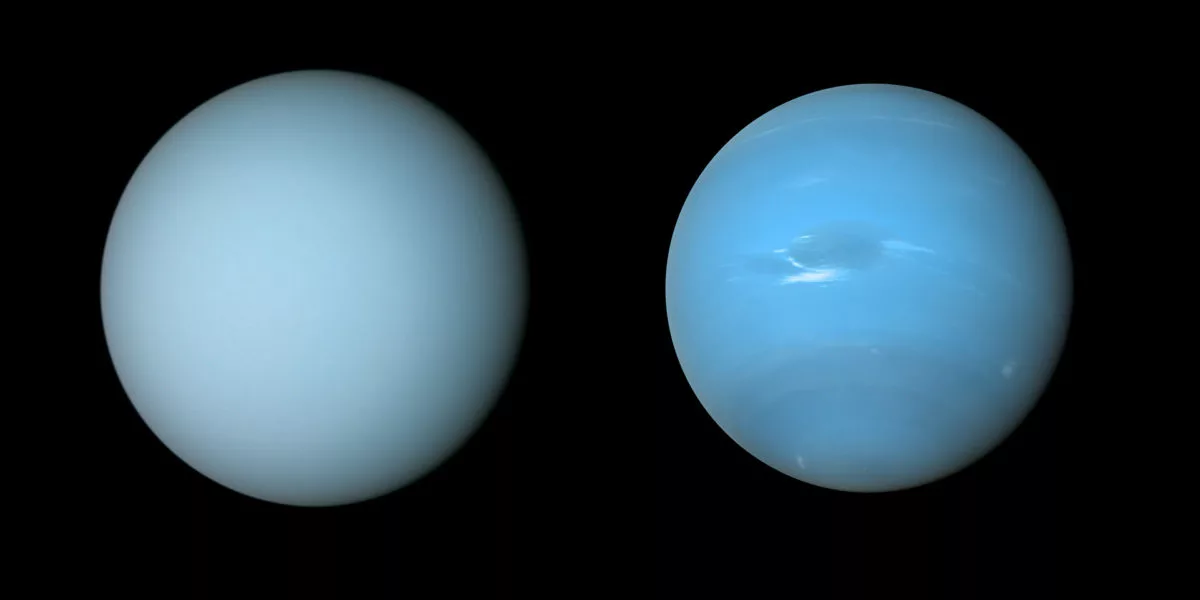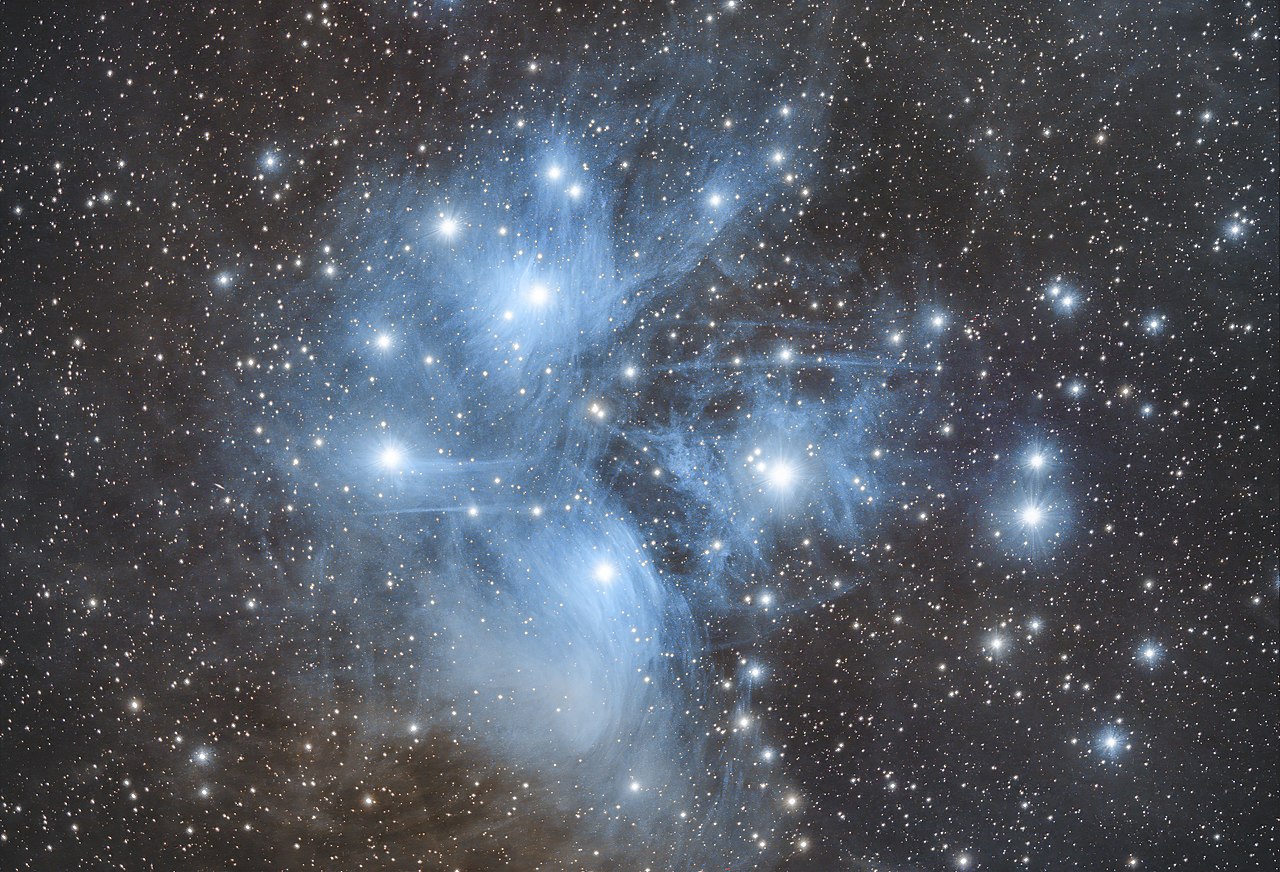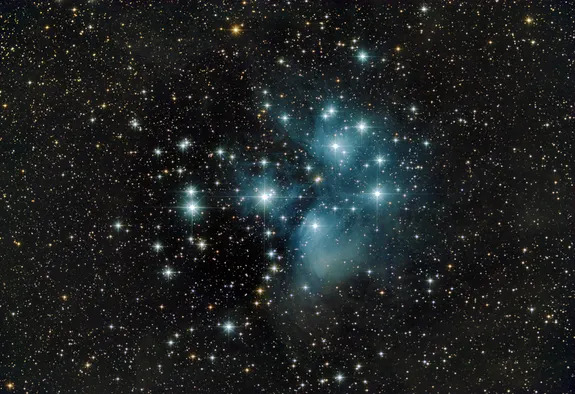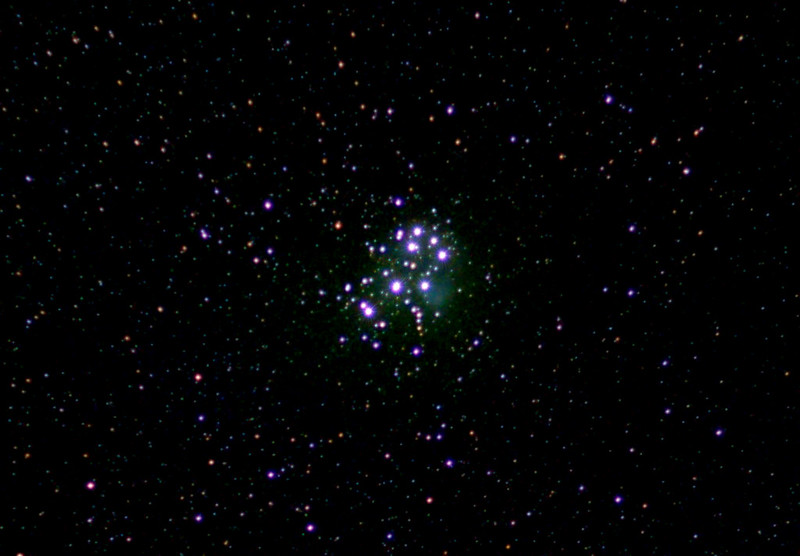Page 1 of 1
APOD: Blood Moon, Ice Giant (2022 Nov 11)
Posted: Fri Nov 11, 2022 5:06 am
by APOD Robot
 Blood Moon, Ice Giant
Explanation: On November 8 the Full Moon
Blood Moon, Ice Giant
Explanation: On November 8 the Full Moon turned blood red as it slid through Earth's shadow in a beautiful total lunar eclipse.
During totality it also passed in front of, or
occulted, outer planet Uranus for eclipse viewers located in parts of northern America and Asia. For a close-up and wider view these two images were taken just before the occultation began, captured with different telescopes and cameras from the same roof top in Shanghai, China. Normally very faint compared to a Full Moon, the tiny,
pale, greenish disk of the
distant ice giant is just to the left of the Moon's edge and about to disappear behind the darkened, red lunar limb. Though only visible from certain locations across planet Earth, lunar occultations of planets are
fairly common. But for this rare "lunar eclipse occultation" to take place, at the time of the total eclipse the outer planet had to be both at opposition and very near the ecliptic plane to
fall in line with Sun, Earth, and Moon.
Re: APOD: Blood Moon, Ice Giant (2022 Nov 11)
Posted: Fri Nov 11, 2022 6:12 am
by Ann
Capturing Uranus at the limb of the eclipsed Moon is a very fine achievement! Congratulations!
But of course... I am not the Color Commentator for nothing. So what about the color of Uranus? This is what it looks like in the APOD:
What does Uranus look like in other pictures? Here is a sample:
The color of Uranus is quite subtle. I think, nevertheless, that it is more cyan and less green than what we see in the APOD.
Ann
Re: APOD: Blood Moon, Ice Giant (2022 Nov 11)
Posted: Fri Nov 11, 2022 1:42 pm
by orin stepanek
My first look at the photo; i thought of the crater & then i read the
APOD!

I put a circle around Uranus!

Thanks Ann; for your post
about the Ice giants!
Re: APOD: Blood Moon, Ice Giant (2022 Nov 11)
Posted: Fri Nov 11, 2022 5:07 pm
by MarkBour
Ann wrote: ↑Fri Nov 11, 2022 6:12 am
Capturing Uranus at the limb of the eclipsed Moon is a very fine achievement! Congratulations!
But of course... I am not the Color Commentator for nothing. So what about the color of Uranus? This is what it looks like in the APOD:
APOD 11 November 2022 detail.png
What does Uranus look like in other pictures? Here is a sample:
<<< images >>>
The color of Uranus is quite subtle. I think, nevertheless, that it is more cyan and less green than what we see in the APOD.
Ann
That is really an amazing capture.
Thinking about Ann's comments, I wondered why Uranus might appear more green in today's APOD than in the JPL images.
Briefly, it occurred to me that Uranus might be experiencing the same light filtering that the Moon was experiencing, as it passed into Earth's shadow. Of course this is totally incorrect! I had to think for a moment.
Uranus looks like a small item right by the Moon, so it seemed like it ought to be getting eclipsed as well. But that's just one of the funny things about light and geometry and the vast distances in space. From Uranus, they would have seen only a transit of Earth (and our moon) across the Sun. And the dark image of the Earth/Moon across the Sun from the vantage of Uranus would be just a very tiny speck on the Sun's face, so it would have no noticeable effect on the illumination that Uranus received at *any* time in question here. Also, a bit confusing, the light travel time to Uranus is about 2.5 hours, so the image we see of Uranus here is actually the light the planet reflected at a noticeably different time than the time of this alignment, anyway!
So, I still wonder why Uranus appeared more green in this apparently true-color image than JPL had rendered it in its attempt to render the true color of the planet to human eyes. We are, in today's APOD, still seeing its light after it passes through Earth's atmosphere, so I assume that is affecting the color. Blue light scatters well in our atmosphere, so everything we see from space in ground-based telescopes must appear "less blue" than it "really" is. Is that something that people adjust for when characterizing the colors of stars, or is it just taken as a given? Then space-based scopes like Hubble or Gaia do not have this problem.
Re: APOD: Blood Moon, Ice Giant (2022 Nov 11)
Posted: Fri Nov 11, 2022 6:17 pm
by Ann
MarkBour wrote: ↑Fri Nov 11, 2022 5:07 pm
Ann wrote: ↑Fri Nov 11, 2022 6:12 am
Capturing Uranus at the limb of the eclipsed Moon is a very fine achievement! Congratulations!
But of course... I am not the Color Commentator for nothing. So what about the color of Uranus? This is what it looks like in the APOD:
APOD 11 November 2022 detail.png
What does Uranus look like in other pictures? Here is a sample:
<<< images >>>
The color of Uranus is quite subtle. I think, nevertheless, that it is more cyan and less green than what we see in the APOD.
Ann
That is really an amazing capture.
Thinking about Ann's comments, I wondered why Uranus might appear more green in today's APOD than in the JPL images.
Briefly, it occurred to me that Uranus might be experiencing the same light filtering that the Moon was experiencing, as it passed into Earth's shadow. Of course this is totally incorrect! I had to think for a moment.
Uranus looks like a small item right by the Moon, so it seemed like it ought to be getting eclipsed as well. But that's just one of the funny things about light and geometry and the vast distances in space. From Uranus, they would have seen only a transit of Earth (and our moon) across the Sun. And the dark image of the Earth/Moon across the Sun from the vantage of Uranus would be just a very tiny speck on the Sun's face, so it would have no noticeable effect on the illumination that Uranus received at *any* time in question here. Also, a bit confusing, the light travel time to Uranus is about 2.5 hours, so the image we see of Uranus here is actually the light the planet reflected at a noticeably different time than the time of this alignment, anyway!
So, I still wonder why Uranus appeared more green in this apparently true-color image than JPL had rendered it in its attempt to render the true color of the planet to human eyes. We are, in today's APOD, still seeing its light after it passes through Earth's atmosphere, so I assume that is affecting the color. Blue light scatters well in our atmosphere, so everything we see from space in ground-based telescopes must appear "less blue" than it "really" is. Is that something that people adjust for when characterizing the colors of stars, or is it just taken as a given? Then space-based scopes like Hubble or Gaia do not have this problem.
I think that the answer is that different persons process their pictures differently, and the color balances of their pictures are different.
To understand what I mean, take a look at these pictures of the Pleiades:
As you can see, there are a lot of differently color-balanced Pleiades images here! The picture that I like the best is the last one, because that is the one that looks most like what the Pleiades looked to me, when I observed them through a telescope and committed their color to memory. Still, the real Pleiades were not as saturated as they are in the picture by ESA/Hubble. Nevertheless, that's a good rendition of the color of the Pleiades, I think.
So, Mark, why does Uranus look so green in today's APOD? Well, duh. People process their images differently. And Uranus certainly
is sort of green-
ish - just not as green as it is made to look in today's APOD, if you ask me.
Ann
Re: APOD: Blood Moon, Ice Giant (2022 Nov 11)
Posted: Fri Nov 11, 2022 6:57 pm
by De58te
I believe the green color is also caused by photo processing. Different transistor circuits can produce different shades of color. I notice that when shopping for TV monitors in electronic stores. Different manufacturer sets show different shades of color, particularly red, even though the store is broadcasting the same video to all sets. Even when I was taking camera photos with the old negative film, colors of the same trees in my back yard for instance looked slightly different if I was using Kodak film or using Fuji film.
Also some people may see colors differently in their eyes. The link here "pale, greenish disk" actually links to an APOD where Uranus looks to me rather pale blue than it looks green. Even the author of the description back then must have eyes similar to mine since he called it the blue hue of the atmosphere instead of the green hue.
Re: APOD: Blood Moon, Ice Giant (2022 Nov 11)
Posted: Fri Nov 11, 2022 10:05 pm
by Ironwood
So an observer at Uranus would have seen a transit of the Earth. Pretty cool.
Re: APOD: Blood Moon, Ice Giant (2022 Nov 11)
Posted: Fri Nov 11, 2022 11:55 pm
by heehaw
It is also exciting when Jupiter disappears for a while behind the Sun.
Re: APOD: Blood Moon, Ice Giant (2022 Nov 11)
Posted: Sat Nov 12, 2022 12:41 am
by Chris Peterson
Ironwood wrote: ↑Fri Nov 11, 2022 10:05 pm
So an observer at Uranus would have seen a transit of the Earth. Pretty cool.
Without thinking too hard about the effects of astronomical aberration (the error in apparent position due to the finite speed of light), it would actually be a double transit. The Moon would transit the Earth while the Earth was transiting the Sun.
Re: APOD: Blood Moon, Ice Giant (2022 Nov 11)
Posted: Sat Nov 12, 2022 7:37 pm
by MarkBour
Chris Peterson wrote: ↑Sat Nov 12, 2022 12:41 am
Ironwood wrote: ↑Fri Nov 11, 2022 10:05 pm
So an observer at Uranus would have seen a transit of the Earth. Pretty cool.
Without thinking too hard about the effects of astronomical aberration (the error in apparent position due to the finite speed of light), it would actually be a double transit. The Moon would transit the Earth while the Earth was transiting the Sun.
That sounds pretty nice!
I wonder if it would be harder or easier to capture for an astronomer on Uranus than it is for us to capture a transit of Mercury or Venus. I don't know what special equipment is used for such Solar photography. I'd guess the disks of the Sun. Earth and Moon viewed from Uranus are all smaller, compared to the angular sizes of the disks of the Sun and Venus viewed from Earth. The glare of the Sun at Uranus is much less than it is here, but I don't know how much of that matters. I doubt that any deep space probe ever tried to capture a transit of Earth & Moon over the Sun from the outer solar system. It would be cool, but pretty bogus for a deep space mission, which costs a lot of money and goes for specific purposes. Of course they do occasionally take a snapshot looking back. Some of those snapshots (Cassini and Voyager) have made a huge impact on our species' collective self-image, I think.
Re: APOD: Blood Moon, Ice Giant (2022 Nov 11)
Posted: Sat Nov 12, 2022 7:48 pm
by MarkBour
Ann wrote: ↑Fri Nov 11, 2022 6:17 pm
. . .
So, Mark, why does Uranus look so green in today's APOD? Well, duh. People process their images differently. And Uranus certainly
is sort of green-
ish - just not as green as it is made to look in today's APOD, if you ask me.
Ann
==========
De58te wrote: ↑Fri Nov 11, 2022 6:57 pm
I believe the green color is also caused by photo processing. Different transistor circuits can produce different shades of color. I notice that when shopping for TV monitors in electronic stores. Different manufacturer sets show different shades of color, particularly red, even though the store is broadcasting the same video to all sets. Even when I was taking camera photos with the old negative film, colors of the same trees in my back yard for instance looked slightly different if I was using Kodak film or using Fuji film.
. . .
Thanks, Ann and De58te. I tend to forget about that. So even when capturing with a "regular" camera, and not talking about filters, or false-color palettes and such, there's still variation in processing to consider.
Re: APOD: Blood Moon, Ice Giant (2022 Nov 11)
Posted: Sat Nov 12, 2022 7:53 pm
by Chris Peterson
MarkBour wrote: ↑Sat Nov 12, 2022 7:37 pm
Chris Peterson wrote: ↑Sat Nov 12, 2022 12:41 am
Ironwood wrote: ↑Fri Nov 11, 2022 10:05 pm
So an observer at Uranus would have seen a transit of the Earth. Pretty cool.
Without thinking too hard about the effects of astronomical aberration (the error in apparent position due to the finite speed of light), it would actually be a double transit. The Moon would transit the Earth while the Earth was transiting the Sun.
That sounds pretty nice!
I wonder if it would be harder or easier to capture for an astronomer on Uranus than it is for us to capture a transit of Mercury or Venus. I don't know what special equipment is used for such Solar photography. I'd guess the disks of the Sun. Earth and Moon viewed from Uranus are all smaller, compared to the angular sizes of the disks of the Sun and Venus viewed from Earth. The glare of the Sun at Uranus is much less than it is here, but I don't know how much of that matters. I doubt that any deep space probe ever tried to capture a transit of Earth & Moon over the Sun from the outer solar system. It would be cool, but pretty bogus for a deep space mission, which costs a lot of money and goes for specific purposes. Of course they do occasionally take a snapshot looking back. Some of those snapshots (Cassini and Voyager) have made a huge impact on our species' collective self-image, I think.
Transits of any of the inner planets across the Sun would be readily detectable from Uranus with modest telescopic and imaging equipment.
There would be no reason to design a space mission just to capture such a transit, but there are serendipitous opportunities. Earth transited the Sun from Mars in 1984, but there wasn't anything there that was able to capture that. There will be another such transit in 2084, which I imagine has a good chance of being recorded. Mercury was imaged transiting the Sun from Mars by the Curiosity rover in 2014.
 Blood Moon, Ice Giant
Blood Moon, Ice Giant







